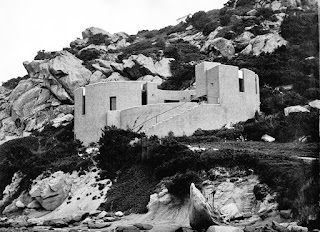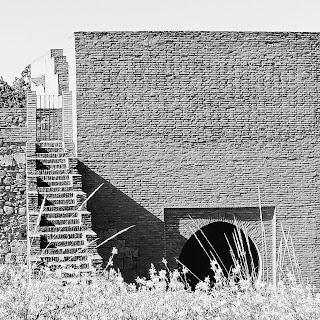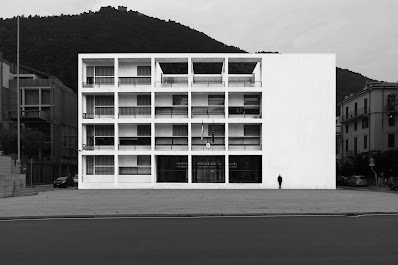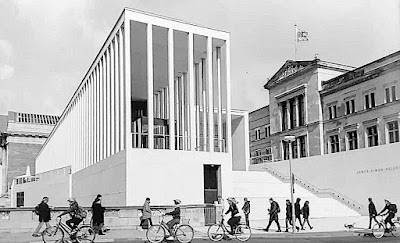Sunday, August 31, 2025
Saturday, August 30, 2025
Setenta anos dos Eidos
Saíu do prelo en agosto de 1955 e fixo de Novoneyra un autor famoso “cando máis gusta selo, dos 25 aos 30 anos”, dicía o mesmo poeta. “O libro vai, flúe”, escribiu Otero Pedrayo meses antes da publicación nas páxinas de La Noche, avanzando o que sería o destino dunha obra que, como as augas, rube, baixa, camiña subterránea e aflora pola segunda metade do século XX, por entre outros libros do autor, con sete edicións distintas da súa man tamén no 1974, 1981, 1985, 1987, 1988 e 1990. “Estades fritindo un peixe vivo”, dixera Carlos Maside aos primeiros editores de Galaxia. Así xustificaba o seu amigo, o pintor que o unira coa xeración trabada das vangardas polo golpe de Estado, a teima do poeta en facer cambios ata o último momento. Dende moi cedo debeu ser para Novoneyra un libro en curso, que catro meses despois de dalo ao prelo escribíalle a Ramón Piñeiro que Os eidos seguían medrando “e definíndose cada vez máis”. Compartía Novoneyra co seu amigo Carlos Oroza esa certa reticencia á palabra impresa, a todo o que ela poda: a entoación, o grafismo do caligrama, a variación da Lingua-Fala, a liberdade da lingua sen mans. E tamén, a teima. Respondía en 1993 nunha entrevista a Olga Patiño Nogueira: “Eu sabía que había cousas escritas en min que a palabra xusta aínda sen deter o pensamento. É dicir, que tiña que buscar máis dunha década, ás veces máis de dúas. De aí a constante reelaboración e progresiva precisión dos poemas de Os eidos e que estas non sexan caprichosas nin obedezan a unha precisión e formalismos vanos”. Para seguir o curso dese río que son Os eidos poderiamos falar de distintas capas, de diferentes estratos. Do caudal, por exemplo, seguindo as amencias que tanto gustaban a Novoneyra por xa dar noticia dun “posible distinto”: así, fronte aos 81 poemas da edición de 1955, a última suma 196. Do seu movemento na páxina, que primeiro os fai baixar, logo subir, e finalmente facer unha onda, coma o do Courel. “Si, algo, algo, algunha significación profunda debe ter para min a distribución do poema no espazo da páxina”, dicía o poeta por esa manía de pegarlles voltas. Ou da puntuación, que cambia en todos os poemas ata a edición de 1981, nunha respiración sen dúbida axustada polos centos de lecturas en voz alta, por algunhas delas da memoria cultural e sociopolítica do país. Outras veces un pequeno cambio produce un xiro copernicano, como ese “Courel dos tesos cumes que se ollan de lonxe!” de 1955, que pasa a ser “Courel dos tesos cumes que ollan de lonxe!” en 1981, porque son os cumes os que nos miran, porque o humano non é o centro. Outros ciclos de escritura tamén deixaron pegadas no libro, como a palabra revolucionaria da Letanía da Galicia —talvez o poema, xunto co Vietnam Canto, máis paradigmático do espírito do 1968 en Galicia— e a palabra solta de Poema Mundo Laxeiro, no que tropelea o barroco e a muiñeira e que o poeta dedicou ao pintor que ilustrara a segunda edición. Nel están tamén as cicatrices da ditadura. O tempo e o espazo de enunciación, cravados no poema: “O Ferrol/8 da mañá/10.03.1972”, cos nomes de Amador Rei Rodríguez e Daniel Niebla García, e con eles a dignidade fronte aos fusís. Ou o de Daniel Pino, e con el todos os presos políticos da cadea franquista. Tamén a propia biografía do poeta entrou en diálogo co libro, cos poemas da neve a “Elba que veu pro Courel”, ou con “Branca Uxío Arturo”, que quedarán “no futuro/que siga o pasado/E ti Galicia a durar/aunque se funda o lousado/e caia neve no lar”, coa fenda desa agonía do rural, para o poeta “a ferida máis quente de Galicia”. Todo quedou en Os eidos. E tamén todos quedaron nel. Se na primeira edición son só catro os nomes de persoa que aparecen, na segunda parte suman xa 40, e na edición conxunta de 1981 contamos 63. Nomes que enchen unha praza, república de nomes, un país como suma de singularidades, que marcan a traxectoria do poeta e pespuntan o libro no curso cultural e sociopolítico da segunda metade do século XX, onde se mantivo sempre presente. Preguntábase Maurice Blanchot por ese xesto que leva un autor a pasar polo xa escrito, a volver dicir, a volver escribir, e establecía a súa razón de ser no imposible cara ao que a obra se dirixe, á súa tensión, o seu corazón. Cantas veces tamén dixo o poeta que a súa poesía non tiña que ver coa paisaxe, que non era “unha contemplación branda da terra”, senón un canto tenso, como tensa era a atención que a atención levaba: “Quizais é o que sostén a tensión do libro, ese ir á terra buscar un soporte non enganoso”, díxolle a Emilio Araúxo. O souto aos pobos, a mesma busca dunha posibilidade de relación, en Folga Xeral Contra da Historia: “O que reduce o home é o mesmo que reduce o bosque, o souto. Unha crecente confusión sobre o límite do colectivo”. Iso que non está dito aínda, que sempre está por dicir, os soños testemuños dos que dá noticia a mirada: “Qué é a coto do ucedo?/Van os tesos pro inverno/...É a serra que o ceo se enleva?/É o ceo que baixa?/É a nebra ou a brétama da ollada?/Non sei en que agarda a terra/Qué agarda a alma./Eu ben sei que a certa é a seguranza./Eu non sei en se certa a seguranza./Eli ónde ollar vai e ven un xeito/ hai algo certo./Ben o soupo de neno ó ollar primeiro/ E inda ha volver teimar a teima./Por onde me veo esta certeza?/heina volver perder e volver ela”. Así tamén volven Os eidos, sempre por dicir, no son continuo da súa corda tensa. A atención crítica que tiveron durante ese medio século seguíronse sumando edicións e achegas, algunhas delas propiciadas polo Festival dos Eidos. Un dos poetas que hoxe recita nesta cita na casa natal do poeta en Parada do Courel, Mohamad Bittari, está traducíndoos ao árabe. Para eses eidos cos que Novoneyra nomeaba os “espazos íntimos, as fincas preto da casa” atopou o equivalente nas terras de Damasco. Cando as árbores se xuntan para dar unha sombra, o bustan, basatín en plural. Dicía Novoneyra que el non tiña preferencia por ningún dos seus libros, pero que os galegos escolleramos Os eidos, talvez por un fondo de memoria común, que é tamén memoria da nosa “condición como seres que pertencemos ao núcleo ou entraña dun planeta, ao mundo da súa codia e aos ceos distantes”, como indicou Chus Pato a propósito do libro. Unha memoria que volve sempre, e contra a depredación da terra e o espolio do planeta, estende o seu “tecido de eros”: “Gran boi deitado/serra do sol/onde eu son/ca luz o campazo!”. E tocamos o lombo dese boi, e é xa o poeta quen nos mira sempre dende o outro lado da montaña, que nos ensinou a amar.
SPACESHIP SERIES _____________________ ARCHITECTURE HIGH CLASS ____________________ URBANAS
SPACESHIP SERIES is a curated exploration of architectural masterpieces around the world, treating each building as a socioplastic totem, a unique, ready-made artifact that reflects its cultural and spatial context. Each entry serves as a didactic tool, blending architectural research with a poetic reinterpretation of urban form and identity.
160 RONCHAMP - Las formas fluidas y el colosal grosor del muro erigen un mamut en la colina. LE CORBUSIER en sus años maduros ya traslada y traduce sus formas pictóricas en espacios. El legado del purismo.
https://es.wikipedia.org/wiki/Villa_Emo
https://www.google.com/search?q=VILLA+EMO+PALLADIO&client=firefox-b-d&sxsrf=ALeKk00JRQqZBfjpqHPIoYq8yl97Lkf3IA:1587991317938&source=lnms&tbm=isch&sa=X&ved=2ahUKEwi7z6XT0IjpAhVHyxoKHXTbCcgQ_AUoAXoECBsQAw&biw=1180&bih=781&dpr=2
SPACESHIPS 146 GENEX TOWER SERBIA
SPACESHIP 145 OSLO CITY HALL
STUDY TRIP NEW YORK NY 2019 WINTER
SPACESHIP 142 YALE CENTER FOR BRITISH ART + ART GALLERY
SPACESHIP 141 DIA:BEACON NY CONTEMPORARY MUSEUM
SPACESHIP 140 UNITED NATIONS
SPACESHIP 139 FORD FOUNDATION KEVIN ROCHE
SPACESHIP 138 ROCKEFELLER GUEST HOUSE
SPACESHIP 137 GROUND ZERO 9/11 MEMORIAL
SPACESHIP 136 EMPIRE STATE BUILDING
SPACESHIP 135 CHRISTLER BUILDING
SPACESHIP 134 GAGOSIAN GALLERY
SPACESHIP 133 CHELSEA MARKET
SPACESHIP 132 HIGH LINE PARK
SPACESHIP 131 DIA CHELSEA
SPACESHIP 130 CENTRAL PARK
SPACESHIP 129 COOPER UNION
SPACESHIP 128 JUDD FOUNDATION SOHO HISTORIC CAST-IRON DISTRICT
SPACESHIP 127 STOREFRONT FOR ART AND ARCHITECTURE
SPACESHIP 126 432 PARK AVENUE CONDOMINIUMS
SPACESHIP 125 SEAGRAM BUILDING
SPACESHIP 124 ROCKEFELLER CENTER
SPACESHIP 123 FRANK LLOYD WRIGHT, OIIO ARCHITECTURE OFFICEÇ
SPACESHIP 122 MARCEL BREUER, REM KOOLHAAS, MICHEL GRAVES,
RENZO PIANO
SPACESHIP 121 RENZO PIANO BUILDING WORKSHOP RPBW ARCHITECTS
SPACESHIP 120 CALVERT VAUX, JACOB WREY MOULD, RICHARD MORRIS HUNT,
RICHARD HOWLAND HUNT, MCKIM, MEAD & WHITE,
ROCHE-DINKELOO, KEVIN ROCH
SPACESHIP 119 MAX ABRAMOVITZ, WALLACE K. HARRISON,
PHILIP JOHNSON, PIETRO BELLUSCHI,
FXFOWLE ARCHITECTS, GORDON BUNSHAFT,
LEE S JABLIN, EERO SAARINEN,
DILLER SCOFIDIO, RENFRO, DAVIS,
BRODY AND ASSOCIATES, BILL
SPACESHIP 118 PHILIP L. GOODWIN, EDWARD DURELL STONE,
PHILIP JOHNSON,
CESAR PELLI & ASSOCIATES,
EDWARD DURELL STONE ASSOCIATES,
DILLER SCOFIDIO + RENFRO
SPACESHIP 117 SANAA KASUJO SEJIMA REM KOOLHAAS
NY NY
SPACESHIP 116 SVERRE FEHN VENICE 1960
STUDY TRIP NTNU ARCHITECTURE MASTER COURSE
MÁLAGA CÓRDOBA GRANADA APRIL 2019
http://antolloveras.blogspot.com/2019/04/ntnu-architecture-masters-series-trip.html
SPACESHIP 114 ROMANO MUSULMÁN - PUENTE CÓRDOBA
SPACESHIP 113 NIETO SOBEJANO
SPACESHIP 112 ABDERRAMÁN III CALIFATO DE CÓRDOBA
SPACESHIP 111 PATRIMONIO INDUSTRIAL
SPACESHIP 110 GUTIÉRREZ
SPACESHIP 109 PÉREZ GARCÍA
SPACESHIP 108 RUIZ
SPACESHIP 107 OFIS
SPACESHIP 106 DE LA COUR
SPACESHIP 105 MAUS - ART
SPACESHIP 104 EMIR ABDERRAMÁN I
SPACESHIP 103 ALTO IMPERIO ROMANO
SPACESHIP 102 SIZA SANTOS
SPACESHIP 101 NASRID EMIR MOHAMMED BEN AL-AHMAR
SPACESHIP 100 TEJEDOR LINARES
SPACESHIP 099 PÉREZ GARCÍA MARÍN
SPACESHIP 098 PARDO GARCÍA FRADE
SPACESHIP 097 SOTO JAÚREGUI GARCÍA
SPACESHIP 096 BAÑOS DEL CARMEN
SPACESHIP 095 ROLDÁN GONZÁLEZ
SPACESHIP 094 PÉREZ MARÍN
SPACESHIP 093 GALLEGOS ARANGUREN
SPACESHIP 092 CABRERO SÁNCHEZ DE LA TORRE
SPACESHIP 091 SORIANO BENEDICTO
SPACESHIP 090 ABDERRAMÁN III EMIR
SPACESHIP 089 GLUCKMAN MAYNER MARTÍN DELGADO
SPACESHIP 088 L35
SPACESHIP 087 JUNQUERA
SPACESHIP 086 OAM GG2
> GET FULL FOLDER HERE
THE ONGOING SPACESHIP SERIES BUILD A VERY USEFUL DIDACTICAL RESEARCH AND STUDY TOOL FOR ARCHITECTURE STUDENTS AND ARTISTS
082 GRASSI
034 BARRAGÁN
010 RIETVELD SHROEDER
009 MAISON DE VERRE
008 MIES NIEWE GALLERY
004 VAN DEN BROEK EN BAKEMA




















.jpg)
.jpg)




























.webp)
.jpg)
.jpg)




.webp)
.jpg)





























_(6339770591).jpg)















.jpg)

















